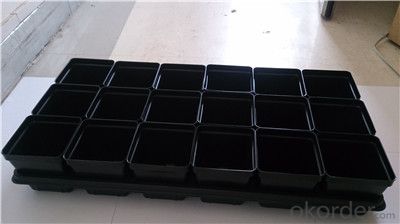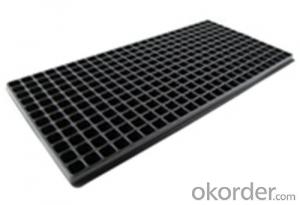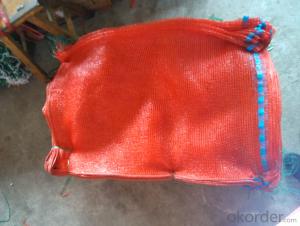Seed Tray Nursery Tray Plastic Tray with Cells Used for Greenhouse
- Loading Port:
- China main port
- Payment Terms:
- TT OR LC
- Min Order Qty:
- 3000 pc
- Supply Capability:
- 10000000 pc/month
OKorder Service Pledge
OKorder Financial Service
You Might Also Like
Product Description:
Advantages:
Top quality and competitive price.
Variety design and good appearance.
Easy to use, and remove.
Durable and reusable.
Eco-Friendly.
Application:
Ideal for Starting seeds and Transplanting Seedling.
Suitable for both manual and automatic planting.
Suitable for Propagating Vegetables, Flowers and other plant from seed in green-house or indoors.
Specification:
Material: HIPS/PVC
Thickness: 0.5mm-1.5mm, Standard:1mm
Weight: 80g(±5)g-230g(±5)g, Standard weight:155g(±5)g
Size: length:490mm-540mm, width:190mm-345mm,depth:25mm-150mm
Standard:54mmX28mm
Cell count: 18-512
Package: carton
Using time: 8-10 times
Thickness vs. Weight
Thickness of trays are from 0.5mm to 1.0mm.
1.0mm: 155g±5g; 100pcs/ctn.
0.9mm: 140g±5g; 120pcs/ctn.
0.7mm: 110g±5g; 150pcs/ctn.
0.6mm: 95g±5g; 180pcs/ctn.
0.5mm: 80g±5g; 200pcs/ctn.
Using time:
thickness of 0.5mm can be used 1 to 2 times.
thickness of 0.6mm can be used 3 to 4 times.
thickness of 0.7mm can be used 5 to 6 times.
thickness of 0.8mm can be used 7 to 8 times.
thickness of 0.9mm can be used 8 to 9 times.
thickness of 1.0mm can be used 8 to 10 times.
Weight and thickness as follows
| Thickness | Weight |
| 0.5mm | 80g±5g |
| 0.6mm | 95g±5g |
| 0.7mm | 105g±5g |
| 0.8mm | 125g±5g |
| 0.9mm | 140g±5g |
| 1.0mm | 155g±5g |
| 1.1mm | 170g±5g |
| 1.2mm | 185g±5g |
| 1.3mm | 200g±5g |
| 1.4mm | 215g±5g |
| 1.5mm | 230g±5g |


- Q: How do agricultural plastic products improve seedling growth?
- Agricultural plastic products improve seedling growth by providing a controlled environment that promotes optimal growing conditions. Plastic mulch, for example, conserves soil moisture, prevents weed growth, and regulates soil temperature, all of which contribute to improved seedling growth. Additionally, plastic greenhouse covers create a protected environment that shields seedlings from harsh weather conditions, pests, and diseases, allowing them to thrive and grow more efficiently.
- Q: Can ground cover plants be used to reduce soil erosion on riverbanks?
- Yes, ground cover plants can be effectively used to reduce soil erosion on riverbanks. The dense root systems of these plants bind the soil together and prevent it from being washed away by water currents. Additionally, their foliage provides a physical barrier that slows down the flow of water, reducing its erosive force on the riverbank.
- Q: I am looking for a cheap, heatproof plastic that is suitable for use in flasks. Any ideas?
- The highest melting point plastic I found was Polyether ether ketone (PEEK) with a melting point of 640°F. Glass melts at 2600-2900 °F, so plastic flasks are not a viable alternative to glass. The bunsen burner flame using natural gas has a maximum temperature of 3562°F. I suppose you could argue that if liquid was in the flask, the liquid temperature would cool the base of the plastic flask, so it would might work. But plastic is a good insulator as well, so the plastic might start to melt even with liquid in the flask. And if the water boiled away, the flask would melt for sure, unlike a Pyrex glass flask.
- Q: How are plastic bird nettings used in fruit orchards?
- Plastic bird nettings are used in fruit orchards to protect the crops from birds and other animals that might feed on the fruits. The nettings are typically installed over the trees or rows of plants, creating a physical barrier that prevents birds from accessing the fruits. This helps to reduce crop damage and loss, allowing the fruit to grow and ripen undisturbed.
- Q: Can agricultural plastic products be used for shade structures?
- Yes, agricultural plastic products can be used for shade structures. Agricultural plastic films such as shade netting or greenhouse plastic can effectively provide shade and protection to crops, livestock, or other agricultural activities. These plastic products are designed to resist UV radiation and weather conditions, making them suitable for creating shade structures in agricultural settings.
- Q: This is regarding concrete wall and plastic insulation. I would like to know what is the best arrangement/placement for the plastic in order to keep the temperature of the room inside.Is it:Concrete wall, plastic, insulationorConcrete wall, insulation, plastic?Thank you
- you're able to physique the recent partitions with 2 X 4 which incorporate headers over doors and homestead windows if any. The run electrical energy by applying setting up NM type cable. you decide on a complicated stressed smoke detector interior the mattress room and one purely outdoors it. you apart from could choose a 2d technique of egress from a mattress room the two a door or window. you will possibly choose heating of a few sort and wall insulation if against the outdoors of the beginning. you will possibly choose floor protecting. you will ought to purchase a huge e book on homestead progression that tells you approaches to do all this.
- Q: Can nursery trays be used for flower arrangements?
- Yes, nursery trays can be used for flower arrangements. They provide a convenient and practical option for organizing and displaying flowers in a neat and organized manner.
- Q: Can ground cover plants be used to create a natural-looking border or edge?
- Yes, ground cover plants can be used effectively to create a natural-looking border or edge. By selecting low-growing plants with spreading or trailing habits, such as creeping thyme, ajuga, or vinca minor, you can create a beautiful and seamless transition between different areas of your garden or landscape. Ground cover plants not only provide a visually appealing border, but they also help to suppress weeds, retain moisture, and protect the soil, making them a practical and eco-friendly choice.
- Q: Can nursery trays be used for cacti?
- Yes, nursery trays can be used for cacti. The trays provide a convenient and organized way to grow and display cacti, and they also help with drainage. However, it is important to ensure that the trays have proper drainage holes or use a well-draining soil mix to prevent waterlogging, as cacti are susceptible to root rot.
- Q: My horse is scared of plastic.What should I do?
- You need to start de-sensitizing the horse to plastic. A good way is hang plastic along your fence line where she grazes. Try the slow apporach methode of slowly introducing the plastic at a safe distance while she eats. Slowly over time decrease the space between her and the object with the goal being able to touch her with it. Eventually she won't mind the sound. This exercise requires you to do this very slowly, if you move to quick you'll have to start over. Something like this could take a week or a month depending on the time you spend with her.
Send your message to us
Seed Tray Nursery Tray Plastic Tray with Cells Used for Greenhouse
- Loading Port:
- China main port
- Payment Terms:
- TT OR LC
- Min Order Qty:
- 3000 pc
- Supply Capability:
- 10000000 pc/month
OKorder Service Pledge
OKorder Financial Service
Similar products
Hot products
Hot Searches
Related keywords






























